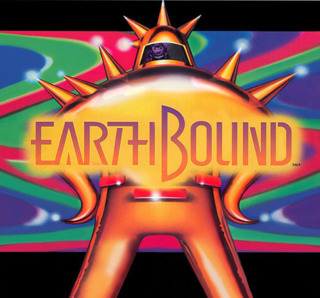It’s nighttime in Onett, a small suburb in Eagleland, a continent reminiscent of a late 1950s/early 1960s America, and a meteorite has crashed on a nearby hilltop. The sound wakes a boy named Ness, prompting him to check out the impact zone, where he is encountered by what appears to be a talking bee named Buzz Buzz, who claims to have come from 10 years in the future to warn Ness of the alien threat, Giygas. Buzz Buzz tells Ness that he must gather his friends and seek out the eight “Your Sanctuary” locations in order to save the world.
So begins Earthbound, a traditional, turn-based JRPG that I for some reason never rented when I was younger, despite having seen it several times on the shelves of my local Power Video. It was a long time before I learned anything about the game beyond the fact that it stars Ness, who remained unknown to me until I unlocked him in Super Smash Bros. Sometime after even that, I learned of Earthbound’s reputation as being well-liked, funny and profoundly bizarre. And so, with its eventual release on the Wii U’s Virtual Console, I finally decided to give it a try.
Maybe the above scenario of time travel, talking bees and places of power doesn’t sound particularly out of place in the context of video games – and world-saving quests are commonplace in pretty much every kind of fiction – but Earthbound’s reputation as being especially strange is well-deserved. While a large part of what makes Earthbound such a surreal experience are the scenarios you find yourself in as the plot progresses, I’m going to focus instead on how the mechanics that replicate the more mundane aspects of the (somewhat) real-world setting serve to make Earthbound far stranger than it could have been if it had abandoned all ties to reality.
Earthbound makes good use of 1960s pseudo-America setting (never mind that the game says it’s set in the ’90s), as is apparent in all of the game’s trappings. Facilities typical to fantasy RPGs such as inns, churches and vendors that operate out of ramshackle, wooden stalls are replaced by hotels, hospitals and modern buildings containing bakeries, pizzerias and drugstores. Status ailments include real-world afflictions such as nausea, sunstroke, and even the common cold. When you run across the more mystical status ailments that a doctor can’t cure, you can consult a new-age spiritual healer conveniently located in every hospital lobby. When not paying medical bills, you can even visit some shady characters to purchase goods that may or may not be strictly legal – namely, bottle rockets and rayguns. And, of course, your school-aged party members get all this money by withdrawing it from ATMs. Because, yes: Ness has a bank account.
Young protagonists in JRPGs are plentiful, but your party members in Earthbound are younger than most, and the game reminds you of how young Ness is in so many ways that society in Earthbound seems more negligent than in, say, Pokemon. Any time Ness returns home from his travels, his mom will make him his favorite food and tell him to scoot off to bed, serving to completely replenish his (and the party’s) HP. This mechanic certainly isn’t unique to Earthbound, but how many games go so far as to let you pick your favorite food when you start a new file? You’ll also have to periodically have Ness call his mom so that Ness doesn’t become homesick, which completely saps him of the will to take action in battle. Then, there’s Ness’ dad, who’s only ever available to talk to on the phone, offering to save your game and depositing money into Ness’ account based on the number of enemies he has defeated.
Aside from being a neat way to establish the relationship between Ness and his parents, phones are another means of conducting business, and phone business in Earthbound is yet another peculiarity. Among your list of contacts is Ness’ little sister, Tracy, who serves as your item bank from the get-go. Eventually, she takes on a part time job with a delivery company called Escargo Express, enabling to you manage your inventory remotely by giving her a call. For a nominal fee, Tracy will send someone to either deliver or pick up your items. This transaction, however, doesn’t take place immediately; you have to wait a few seconds before a delivery person comes running on screen. The same holds true for when you’re ordering a pizza, only the wait is an actual five minutes in real-world time. But, when a large pizza is a powerful, group-healing item, isn’t it worth the wait?
Earthbound goes some strange places: some whimsical, some trippy and some unsettling. But, while things like time travel and aliens perhaps lend themselves better to strange situations than other subject matter, the lengths to which Earthbound goes to establish its own special brand of reality provide a benchmark the makes the game’s out-there moments all the more bizarre.

Log in to comment